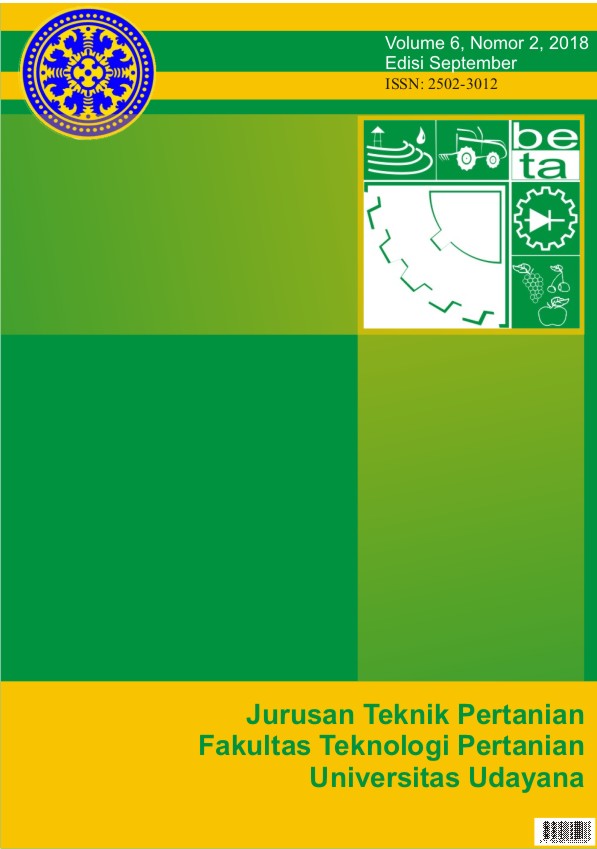Aplikasi Penggunaan Asap Cair terhadap Daya Awet Fillet Ikan Tuna
Abstract
Ikan tuna merupakan komoditi perikanan andalan yang mudah sekali mengalami perubahan mutu. Pengawetan diperlukan untuk memperpanjang umur simpan ikan terutama di saat-saat musim ikan dan agar ikan dapat sampai ke tangan konsumen sebelum mengalami pembusukan. Teknologi pengawetan yang dapat diterapkan adalah pemberian asap cair karena bahan mengandung fenol yang berperan sebagai antioksidan. Tujuan dari penelitian ini adalah mengetahui pengaruh pemberian asap cair terhadap kandungan protein yang terdapat pada fillet ikan tuna dan mengetahui umur simpan fillet ikan tuna dengan penggunaan asap cair sebagai bahan pengawet yang disimpan pada suhu kamar (27o) dengan menggunakan metode ESS (Extended Storage Studies). Konsentrasi asap cair yang digunakan dalam penelitian antara lain konsentrasi asap cair 4%, konsentrasi asap cair 6% dan tanpa pemberian asap cair. Penelitian ini menggunakan metode ESS (Extended Storage Studies) yang diperoleh dari uji sensori selama penyimpanan dengan menentukan kesukaan terhadap penampakan, warna, bau, tekstur dan parameter lain yang diamati yaitu uji pH, kadar air dan uji protein. Hasil penelitian menunjukan bahwa dengan penambahan asap cair tidak mampu mempertahankan kadar protein yang terkandung pada fillet ikan tuna selama proses penyimpanan dengan rata-rata penurunan kandungan protein untuk semua perlakuan sekitar 4,01% dan penambahan asap cair 6% mampu disimpan selama 54 jam, 2,33 kali lebih lama dibandingkan dengan tanpa penambahan asap cair.
Tuna fish is a commodity of fishery products is very easly get change of the quality. Preservation is needed to prolong the life of save the fish especially at the time when the fish season and so that the fish can reach the consumer before experiencing the decay. Preservation technology that can be applied is the giving of liquid smoke because the ingredients contain fenol who act as antioxidants. Objective of this research is to find out the shelf life of tuna fish fillets by using the liquid smoke as preservatives and stored at room temperature (27o). This research uses the method ESS (Extended Storage Studies) obtained from sensory test during storage with determine the gladness of the appearance, color , smell, texture and other parameters observed namely pH test, the level of water and protein test. Based on the research results obtained using the method ESS, shows that the quality of tuna fish fillets with the addition of liquid smoke is best obtained on the treatment of liquid smoke concentration of 6% with long storage time during 54 hours, with the main quality parameters cause damage obtained from pH test results and sensory test.
Downloads
References
Buckle, K. A., Edwards, R. A., Fleet, G. H., & Wootton, M. (1987). Ilmu pangan. Penerbit Universitas Indonesia, Jakarta (Diterjemahkan oleh H, Purnomo dan Adiono).
Darmadji, P. (1996). Aktivitas antibakteri asap cair yang diproduksi dari bermacam-macam limbah pertanian. Agritech, 16(1996).
Girarrd, J. P. (1992). Smoking in Technology of Meat and Meat Product.
Gómez‐Guillén, M. C., Montero, P., Hurtado, O., & Borderias, A. J. (2000). Biological characteristics affect the quality of farmed Atlantic salmon and smoked muscle. Journal of Food Science, 65(1), 53-60.
Goulas, A. E., & Kontominas, M. G. (2005). Effect of salting and smoking-method on the keeping quality of chub mackerel (Scomber japonicus): biochemical and sensory attributes. Food chemistry, 93(3), 511-520.
Guillén, M. D., & Ibargoitia, M. L. (1999). Influence of the moisture content on the composition of the liquid smoke produced in the pyrolysis process of Fagus sylvatica L. wood. Journal of agricultural and food chemistry, 47(10), 4126-4136.
Karseno, K., Darmadji, P., & Rahayu, K. (2002). Daya hambat asap cair kayu karet terhadap bakteri pengkontaminan lateks dan ribbed smoke sheet. Agritech, 21(1), 10-15.
Kusnandar, F. (2006). Desain Percobaan dalam Penetapan Umur Simpan Produk Pangan dengan Metode ASLT (Model Arrhenius dan Kadar Air Kritis). Modul Pelatihan: Pendugaan dan Pengendalian Umur Simpan Bahan dan Produk Pangan, 7-8.
Leroi, F., & Joffraud, J. J. (2000). Salt and smoke simultaneously affect chemical and sensory quality of cold-smoked salmon during 5 C storage predicted using factorial design. Journal of food protection, 63(9), 1222-1227.
Martinez, O., Salmeron, J., Guillen, M. D., & Casas, C. (2007). Textural and physicochemical changes in salmon (Salmo salar) treated with commercial liquid smoke flavourings. Food Chemistry, 100(2), 498-503.
Muratore, G., Mazzaglia, A., LANZA, C., & Licciardello, F. (2007). Effect of process variables on the quality of swordfish fillets flavored with smoke condensate. Journal of Food Processing and Preservation, 31(2), 167-177.
Saparinto, C. (2007). Membuat Aneka Olahan Bandeng. Jakarta: Penebar Swadaya.
Sari, D. K. (2004). Pemanfaatan Asap Cair dengan Bahan Pengasap Kayu Jati Pada Produk Lidah Asap [skripsi]. Bogor: Fakultas Peternakan, Institut Pertanian Bogor.
Sedjati, S. (2006). Pengaruh Konsentrasi Khitosan Terhadap Mutu Ikan Teri (Stolephorus heterolobus) Asinan Kering Selama Penyimpanan Suhu Kamar [Tesis]. Semarang: Program Pascasarjana Universitas Diponegoro.
Soekarto, S. T. (1985). Penilaian organoleptik: untuk industri pangan dan hasil pertanian. Bhratara Karya Aksara, Jakarta.
Sofiah, B. D., & Achyar, T. S. (2008). Penilaian Indera. Fakultas Teknologi Industri Pertanian, Jurusan Teknologi Industri Pangan, Universitas Padjajaran. Jatinangor.
Stohr, V., Joffraud, J. J., Cardinal, M., & Leroi, F. (2001). Spoilage potential and sensory profile associated with bacteria isolated from cold-smoked salmon. Food Research International, 34(9), 797-806.
Supardi, I., & Sukamto, M. (1999). Mikrobiologi dalam Pengolahan dan Keamanan Pangan. Bandung: Penerbit Alumni.
Winarno, F. G. (1982). Kimia Pangan dan Gizi. PT. Gramedia Pustaka Utama, Jakarta.
Winarno, F. G. (1997). Pangan dan Gizi. PT. Gramedia Pustaka Utama, Jakarta..












 Jurnal BETA (Biosistem dan Teknik Pertanian)
Jurnal BETA (Biosistem dan Teknik Pertanian)


